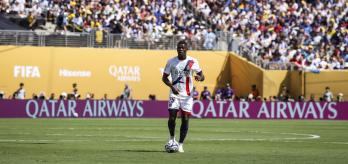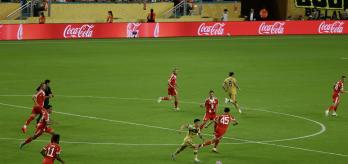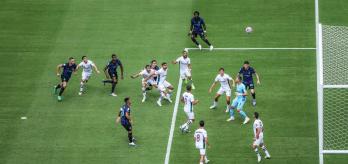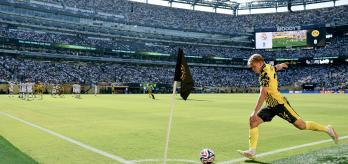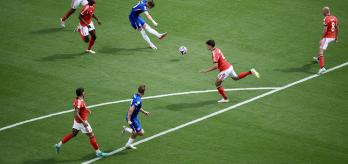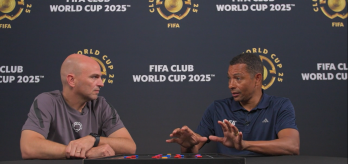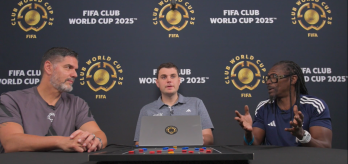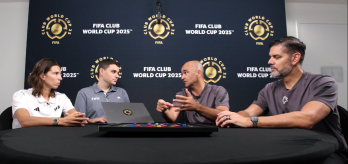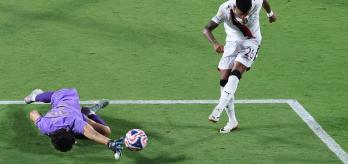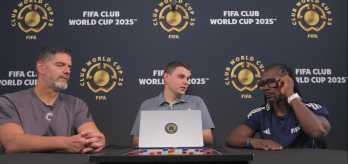The analysis, conducted by our Football Performance Insights Team, reveals that 18 of the 32 competing teams used zonal marking defensive structures, with five teams adopting a player-marking strategy and five operating with a hybrid strategy, while the remaining four teams varied their defensive approaches.
When defending a corner, the three main defensive structures that teams adopt to prevent the attacking team from scoring are:
-
Player marking
-
Hybrid marking
-
Zonal marking
In the clips below, we see examples of all three (zonal, player marking, hybrid) defensive corner setups.
Key findings
Player marking went from the most popular strategy in FIFA World Cup Qatar 2022™ (FWC22) to the least popular in the FIFA Club World Cup 2025 (FCWC25). In this article, we explore the strong emphasis on zonal marking, both as a standalone approach and as a key component within the hybrid- and player-marking systems. As such, this analysis places particular focus on the deployment and effectiveness of zonal players across various defensive setups, assessing their contribution to overall defensive stability and their impact on reducing the attacking teams’ offensive success.
During FCWC25, the strategy of zonal marking was used in 60% of defending corners compared to 31% in FWC22. Player marking as a defensive structure was used in 14% of defensive corners, decreasing by 24% from 38% in 2022. There was a -4% decrease in the use of hybrid-marking structures, down to 24% from 28% in FWC22.
Teams tended to adhere to the same defensive strategy throughout the tournament, regardless of their opponent, with 30/32 teams using only one of either the player marking or zonal marking systems, i.e., if a team used player marking, they did not use zonal marking, and if they used zonal, they did not use player marking.
When the defensive trends were analysed per confederation, the player-marking strategy was preferred by teams from CAF, while zonal marking was the most used across all other confederation teams.
Measuring defensive first contact success
Decreases were reported in defensive first contacts across all three marking strategies compared to FWC22. Zonal marking showed the smallest decrease (-2%) and was the best-performing strategy for defensive first contacts (65%).
Player-marking first-contact success dropped -10% from 72% in FWC22 to 62% in FCWC25, while first contacts in the hybrid system decreased by the largest proportion (-14%) from 71% to 57%.
As can be seen in graphic 6 below, all systems show high proportions of front- and central-defensive first contacts. Zonal marking shows a higher proportion of defensive first contacts within the goal area and from inswinging deliveries, while opposition teams generated the smallest number of attacking first contacts in the goal area (six-yard box) against teams using the zonal-marking system (see graphic 7).
Player marking shows a higher proportion of defensive first contacts from outswinging deliveries, but player marking and hybrid-marking systems conceded a higher proportion of attacking first contacts within the goal area (see graphic 8).
In the clips below, we can see different examples of how defending teams achieved first contact success using each of the three strategies: player marking, zonal marking and hybrid marking.
MEASURING DEFENSIVE SUCCESS – RESTRICTING OFFENSIVE THREAT
During FIFA Club World Cup 2025, there was an increase in the success of attacking teams from corners, with increases in the proportion of attacking first contacts, which led to an increase in attempts at goal and goals conceded. This was present across all defensive strategies. However, zonal marking showed the smallest increase in attacking success.
For corners delivered directly to the penalty area, slight increases were recorded in the proportion of goals conceded in phase one, across all three marking systems, compared to FWC22. An increase of +0.5% was recorded in zonal marking to 3.3%. Player marking had a +1.4% rise to 3.1%, while the largest increase occurred against the hybrid defensive strategy with a jump of 4.4% to 5.9% (see graphic 9).
Attempts at goal also increased across the three systems from phase one of corners, with the smallest rise occurring against the zonal-marking strategy, elevating by +2% to attempts at goal resulting from 28% of corners delivered directly into the penalty area. An increase of +6% to 26% was recorded against the player-marking setup, while the largest rise (+8%) occurred against hybrid-marking structures (+30%) (see graphic 10).
However, attempts at goal in the first phase, delivered directly to the penalty area, against zonal-marking strategies were generated further away from goal (10.2m) than against player marking (2m further) or hybrid strategies (0.6m further) (see graphic 11). Zonal marking produced these results due to the loaded presence of defending players at the front and central parts of the goal, with the remaining zonal players being spread across the six-yard line protecting the goal area (six-yard box). This structure limits attacking opportunities in these key areas, as the defensive team has more control of the space. In addition, zonal marking produced the lowest average xG (0.09) per attempt at goal in the first phase, compared to an xG of 0.12 for player marking and an xG of 0.19 for hybrid marking.
In FCWC25, there was a 10% increase in the proportion of attempts at goal in the second phase (or greater) from outside the penalty area compared to FWC22, with only one goal scored from these scenarios across both tournaments. Also in the second phase, the quality of attempts at goal reduced across all defensive strategies, with lower expected goals recorded per corner (zonal 0.03; player 0.03; hybrid 0.06) compared to the first phase. Against zonal- and player-marking strategies, the xG suggests you would expect three goals from every 100 attempts at goal in the second phase of corners.
Roles within the strategies
The traditional use of front-post and back-post defensive roles featured sparingly across all defending corner strategies during FIFA Club World Cup 2025. However, teams were consistently working and positioning players to protect the space at the front of the goal area. Players operating in zonal roles seek to prevent attacking first contacts in threatening areas; therefore, the increase in the use of zonal players shows that teams are looking at more preventative measures when defending corners. By winning the first contact, they deny an immediate attempt at goal, whereas the traditional role of having players stationed at the front or back post was more reactionary, with the responsibility of stopping the attempt at goal from being scored in that area.
In hybrid systems, an increase was noted in the number of zonal players used, while there were reductions in player marking roles within that system, highlighting the overall trend that more teams adapted zonal-based defensive strategies.
Teams used five or six zonal players to defend against one third (235 of 621) of all corners taken, while defending teams conceded the highest proportion of attempts at goal (29%) in the first phase against teams that used seven or eight zonal players in their defensive setup.
When looking at the location of zonal players across all strategies, there has been a consistent approach of defending the front area with their zonal players. In player marking systems, this has been supported with a secondary zonal player in a central location.
For hybrid systems, the front zone has been supported with additional zonal players positioned across the width of the goal frame and for zonal strategies, teams have looked to use additional players in the front zone, supported by zonal players creating two lines of defence across the width of the goal area in the 6-12-yard space, with further support at the back-post zone.
Protecting the edge/rest attack
When teams had no players designated to protect the edge of the penalty area, 57% of corners entered a second phase, compared to 40% when the defending team had one player positioned to protect the edge.
Player-marking strategies, which tended to have more players assigned to protecting the edge or ‘rest attack’ roles compared to zonal or hybrid strategies, had the fewest corners entering a second or subsequent phase from a corner. Players in these roles or positions were tasked with winning second balls following the first contact and acting as a potential outlet for any defensive clearances or goalkeeper interventions.
Conclusion
As the most used strategy for defending corners during FIFA Club World Cup 2025, zonal marking provided an element of consistency and control for the defensive team by placing defenders in high-traffic areas and dominating that space. The consistency of the zonal setup can provide a clear understanding of individual roles and of the spaces that need to be covered. As a result, the reliance on 1v1 duels in the penalty area reduces because players in zonal marking setups are responsible for defending their allocated zone as opposed to the actions of an individual player.
Zonal strategies allow the defenders in this strategy to split their focus on the delivery of the corner and the movements from the attacking players, whereas in strategies with fewer zonal players, the focus tends to be on tracking attacking movement, making it more difficult to assess the flight and potential location of the incoming delivery.
The increase in preference for teams to use a zonal strategy in club competitions compared to national competitions could be in part due to the increased time the coaches have with the players, enabling a greater focus on set plays. Therefore, the coaching staff of clubs should be afforded a greater opportunity to train the more complex aspects of using a zonal system compared to assigning individual players to mark in player marking systems.







